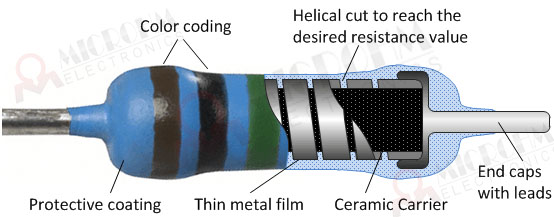The Construction and Features of Metal Film Resistors
In resistor industry, RJ refer to metal film resistor which is usually a cylindrical axial resistor ones. Other film type resistors are carbon film, thick and thin film resistors. The resistor value is marked by color code bands or with text. The Temperature Coefficient of Resistance is usually between 50 and 100 ppm/K.The metal film resistors are available with tolerances of 0.1, 0.25, 0.5, 1 and 2%.
Metal film resistors have good characteristics for tolerance, stability and TCR. What's more, the resistors feature low noise properties and a high linearity because of a low voltage coefficient. Therefore they are often used in active filters, bridge circuits, household electrical appliances, communications, instruments and meters. The appearance of metal film resistors is similar to carbon film resistors, but their properties for stability, accuracy and reliability are considerably better. Wirewound or carbon composition resistors are easier damaged by voltage surges and power overloads.
Metal film resistors have so many merits, how are they constructed? let's figure out.

Metal film resistors are axial resistors with a thin metal film as resistive element. The thin film is deposited on usually a ceramic body.The resistance material is often nickel chromium (NiCr).For better accuracy, the deposited metal is artificially aged by keeping it for a long period at a low temperature. The stability and resistance of metal film resistors are strongly dependent on the thickness of the metal film (50-250 nm). A larger thickness of the layer results in a lower resistance value and a better stability. A metal cover is pressed on both ends with the connection leads. Then the intended resistance is achieved by cutting a spiral shaped slot in the thin metal layer by lasers. The resistor is covered with several coating layers that are baked individually. The coating protects against moisture, mechanical stresses and has a higher dielectric strength.
Latest News
- Resistor's role in measuring and correcting LED,,,
- Single through-hole resistors' characteristics ,,,
- Why shunt resistors for current sense applicati,,,
- Metal-film resistors with small size, high resi,,,
- 36W High-Current Shunt Resistors MMS8420,,,
- 1W Surface Mount Resistor MPR1206,,,
- An Overview of Microhm Electronics' Resistor Pr,,,
- More anti-sulfur resistors used in harsh envir,,,
- Resistance changes with temperature,,,
- 140W TO247 High Power Heatsinkable Resistor,,,
- MMS5930 is ideal for current sensing in industr,,,
- Shunt resistors selection for engineers' design,,,
- Considerations for choosing precision resistors,,,
- Ceramic Encased Cement Resistors NWH Series for,,,
- Resistors for Passive Balancing in Battery-Pow,,,
Hot Articles
- Microhm will take part in 10th Automotive World,,,
- Thanks for Visiting Microhm's Booth E5-5706 in ,,,
- Resistors in Short Supply: Blame Cars,,,
- New lunch: High Power Precision Shunt Resistor,,,,
- How to Test a Resistor,,,
- Innovative Technology, Future Electric: Electri,,,
- What is Precision Resistors?,,,
- SMD Resistors Sizes and Packages,,,
- The Construction and Features of Metal Film Res,,,
- What is a TO-220 Resisor?,,,
- Hot Selling Products: Precision Shunt Resistors,,,
- How to Calculate the Equivalent Resistance Valu,,,
- What is a Fixed Resistor?,,,
- Resistors in LED Circuits,,,
- Resistors Types and Materials Overview,,,
Resistance applications
- Urbanization Development Bringing the Transform,,,
- Carbon Film Resistors' Features and Application,,,
- The Four Important Functions of Alloy Resistors,,,
- Shunt Resistor MMS8420 for High Current Stable ,,,
- Surface Mount Resistor's Size and Package ,,,
- Miniature future for passive electronic compone,,,
- Why Zero-Ohm Resistors?,,,
- BMS for New Energy Vehicle,,,
- Industrial Roberts Applied to Solar Photovoltai,,,
- Precision Resistors' Construction and TCR,,,
- The Main Application for High Precision and Low,,,
- Select the Right Resistor for Harmonic Filterin,,,
- Heater Blower Motor Resistor in Air Conditioner,,,
- Difference Between High Precision Resistors and,,,
- The Measurement Accuracy of Automotive Shunt is,,,
